What Went Wrong at Woodford - a forensic investigation

As a direct equities investor, I've never taken much interest in funds, but you couldn't avoid the Woodford Capital saga. Stockopedia HQ is in Oxford, and it was notable that Neil Woodford decided to set up shop on the ring road here. Initially raising a few billion, before growing assets under management well above £10bn. We tried to interview him a few years ago, but our request was turned down. They were too busy to reply.
To begin with, all you heard about was success. Asset growth, strong performance, fund launches. I received a lot of Hargreaves Lansdown marketing materials at the time, with very glossy pictures & interviews of Woodford that I skimmed. I remember the Patient Capital Trust launch and its positioning as an exceptional opportunity. But I passed on all of these. As mentioned, I've just had no interest in funds.
In 2017 the story began to unravel, with large redemptions and rumours of too many illiquid holdings. Poor performance, then more problems and more redemptions. It began to get interesting, then scandalous. Performance dived with the main fund - the Woodford Equity Income Fund - falling by more than 40% peak to trough. It's now closed and shutting down. Meanwhile something like £100m in dividends had been paid out to Woodford and his partner since the fund launched.
It seems almost every financial journalist in the UK has covered the story. Hundreds of thousands of hurt investors are not happy. Some are taking legal action. What value could we add ?
Our Study
Well once the fund closed to redemptions in June, we got seriously interested. Woodford was well known for being transparent about his fund holdings. We thought we might be able to dig out all the holdings history for analysis. What would we find if we overlaid Stockopedia's share analytics onto Woodford's holdings history? What we discovered was quite extraordinary.
On Monday I performed a 1 hour webinar that unveiled our research. This research is available both as:
- A video replay on Youtube.
- And as a deck of 100 slides on SlideShare.
Over the next couple of weeks we'll be publishing a range of blog posts here, and on social media for anyone who is interested. We're hoping to wrap all this up in an ebook for further distribution too. We'll pick through a few key themes that will hopefully help shine a light on what lessons we can all learn from Woodford.
Key Findings
There are a few key themes that run through the deck, but the most startling relate to the Style Drift and Risk exposures over time. I highly recommend that you watch the Webinar as it will give you the full story, set out over time. Digging into the material yourself is the best way to get the insights... but I'll summarise here with a few key findings.
Woodford initially set out to provide an "Equity Income Fund", that was marketed to hundreds and thousands of investors. One can only presume that so many retirees, divorcees, widows, savers bundled into the fund on the basis of Woodford's historic success at Perpetual and his positioning as Britain's Buffett.
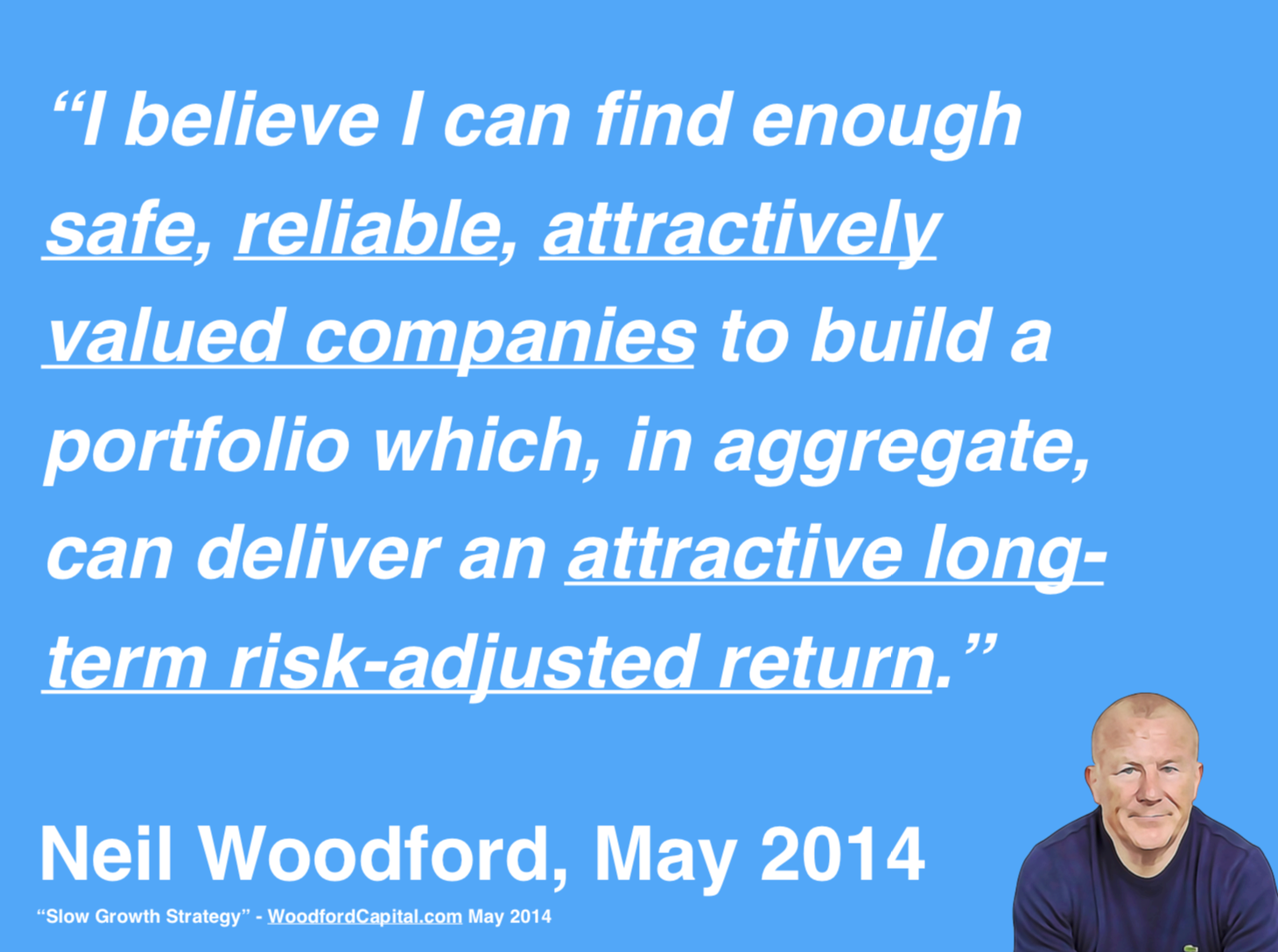
Style Analysis
Our analysis, using the Stockopedia StockRanks as a framework showed that initially Woodford invested heavily in safe, large cap, leading shares. The 2014 portfolio was actually what one might expect based on Woodford's history. It was full of high Quality dividend paying names, including many pharmaceutical and tobacco stocks. But over time, the Style drifted away from these large cap 'High Flyers' as Woodford Capital invested heavily in speculative and unquoted names. The fund style became empirically that of a Momentum Trap. With strong Momentum exposure, but low Quality and Value exposure. Eventually as the fund unravelled, it motored aggressively back into Contrarian, larger cap value names. Seeing these kinds of wild Style shifts in a major fund is quite startling - especially the Momentum exposure in an Equity Income Fund!

Risk Exposure to Unquoted and Highly Speculative Illiquid Investments
Using the Stockopedia RiskRatings, we can assess the proportion of Speculative and Highly Speculative shares in the portfolio. It's well known how many unquoted shares Woodford owned, but what's less well known is just how much risk he was taking across his quoted investments. We found that by 2018 almost 50% of the portfolio was in quoted speculative investments. Stockopedia subscribers will know that Speculative and Highly Speculative RiskRatings tend to have below benchmark returns. There were a great many lottery ticket type investments.

Size Group Exposures
The following chart shows the allocation of the fund to different 'size groups'. Large Caps to Small Caps etc. Blue is the Large Caps. As you can see the exposure ratcheted sharply down from the launch onwards. What would you expect to find in a £10bn Equity Income Fund? I wonder what Terry Smith would say.
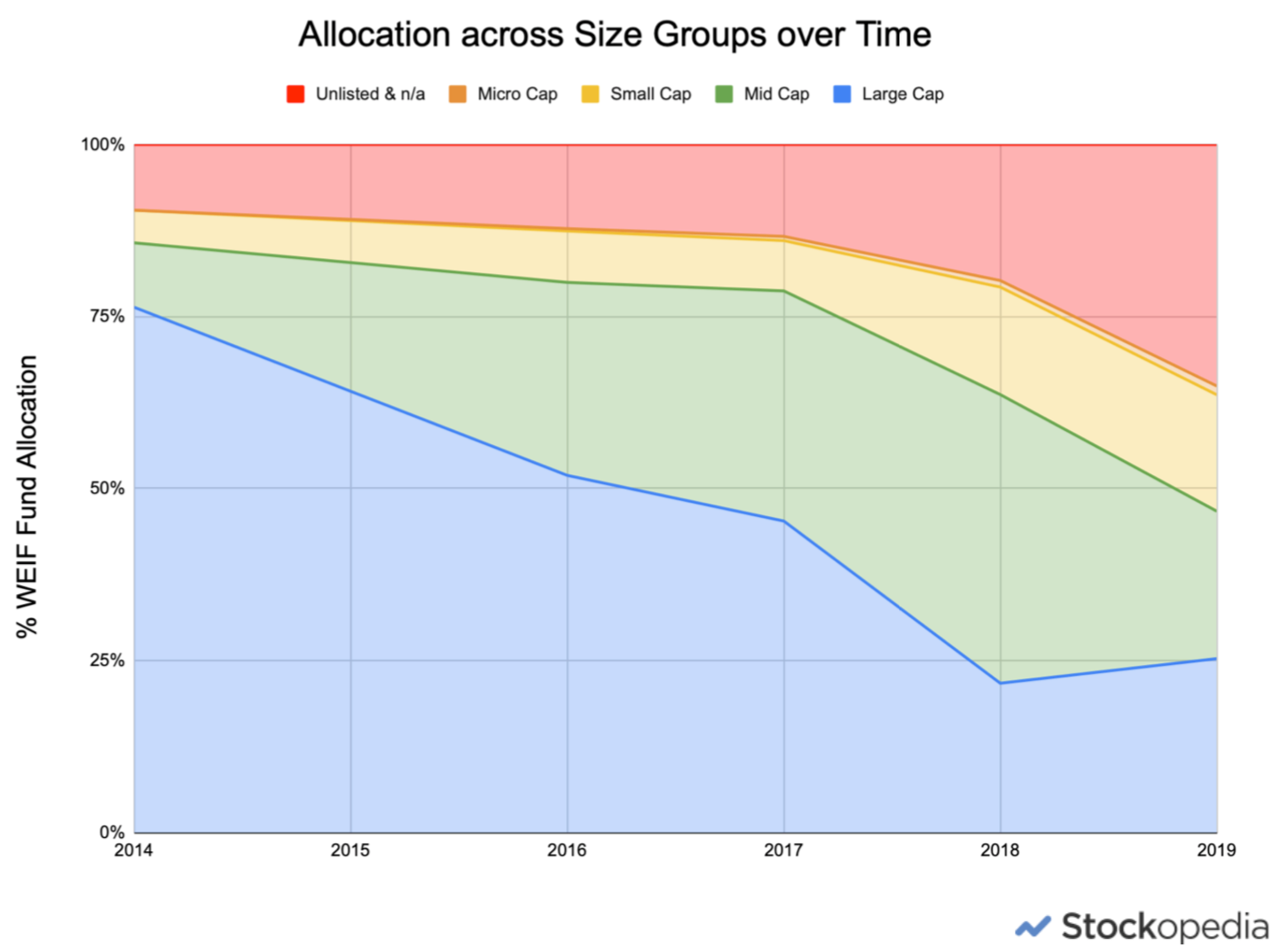
Sector Exposures
I'm just going to highlight the big Healthcare bet that was taken in the fund in this chart. In the full deck you will find many breakdowns of the Sector exposure. But at the end of 2016 there was 40% of the fund invested in Healthcare stocks (according to the TRBC schema we use and Woodford's own framework). This was split between blue chip pharmas like Astrazeneca (LON:AZN) but also heavily in speculative biotech names like Prothena and Northwest Biotherapeutics. There were also many unquoted investments in this sector.
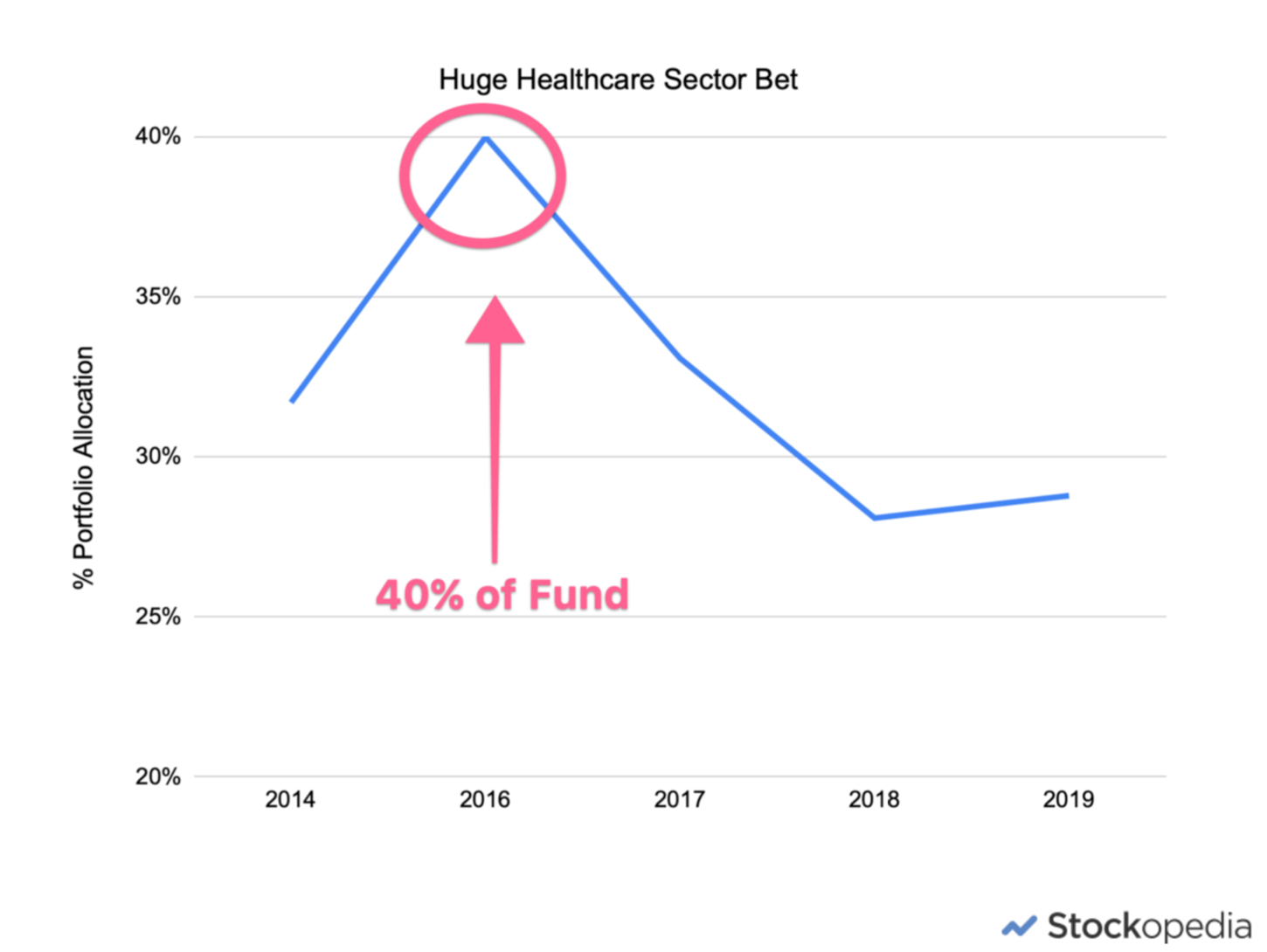
Summary
The following slide summarises the fund's exposures at the peak AUM in 2017. To be honest, these kinds of big bet exposures are the kind of thing that I'd see in an unsophisticated private investor's portfolio that maybe hasn't been through a bear market cycle yet. It's even the kind of portfolio exposure that you'd expect to find summarised in a Barber & Odean research paper. To find this in the most successful fund launch of a generation is just astonishing, and shows that lack of risk controls that the Woodford team had set up.
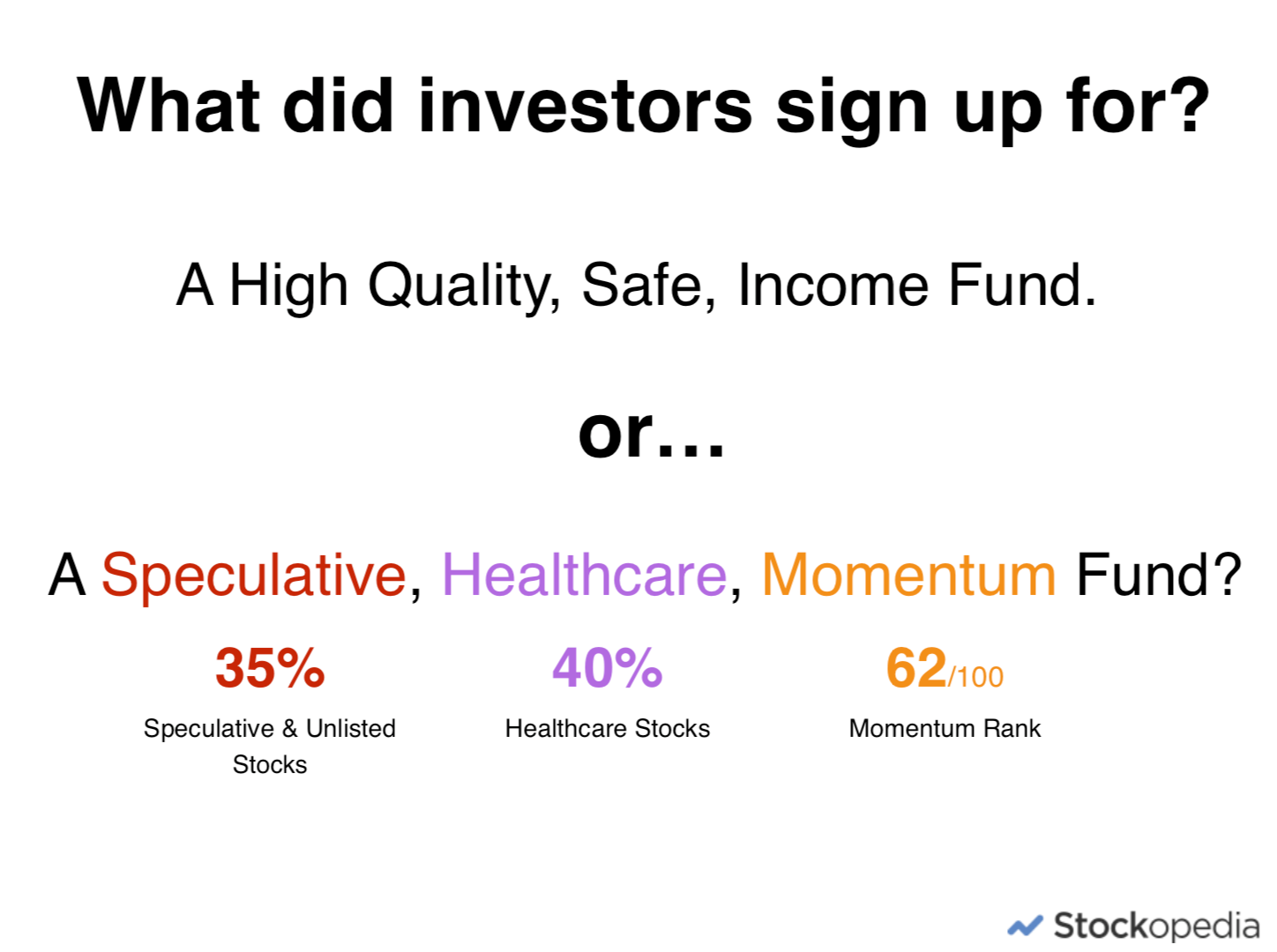
Honestly, I'm disappointed that we didn't look at the fund earlier. I think we could have helped save a lot of people a lot of money. We're known as a share analysis platform, but having made a huge effort on this study, I'm now very keen that we integrate fund data and extend our StockRank analysis to them. It's very expensive to acquire the raw fund data, so I'm not setting timelines but I'm hopeful that we can bridge the gap.
Very interested to hear your comments.

About Edward Croft
Co-founder and CEO here at Stockopedia.com. I was a wealth manager, then full-time private investor before setting up Stockopedia. I believe passionately in the power of data-driven investing to improve investment results. Oddly obsessed with the StockRanks.
Disclaimer - This is not financial advice. Our content is intended to be used and must be used for information and education purposes only. Please read our disclaimer and terms and conditions to understand our obligations.

Ed - you may be interested to know that I did a similar exercise on the Woodford Income Fund in real time and loaded his initial portfolio onto Stockopedia. I quickly identified that his selections were pretty poor from a Stockopedia analysis but I was new to Stockopedia at that time so didn't really take it any further. Whilst clearly the small companies Woodford invested in have been a disaster we shouldn't ignore that his initial stock selection of larger companies was also atrocious. According to my list - which I gave up updating quite quickly - his biggest absolute losses were Capita, BT, Imperial Brands, Centrica, Provident Financial, the AA etc. I still have the list and you are welcome to have it if it would help.
I also echo a lot of the other comments that a fund analysis would be useful - unfortunately only a few are as open as Woodford was ironically but a close approximation is available from annual and semi annual reports. I had a quick look at Miton the other day and a number of holdings in their top 20 don't score well.

I would like to add my appreciation for the research done here, and the great article. I am still getting to grips with the mass of data available here, and how to use it all. Articles like this are so educational.
I suppose Woodford in his defense would probably argue that many of the unlisted stocks picks weren't high risk. He would possibly also argue that had he been able to keep going their potential would eventually have been realised. But they were obviously illiquid positions, which in the quantity he was in to them was incompatible with an open ended fund.
I would very much like to see some data for IT's available on Stocko, but doubt that Unit Trust data would be of much interest to most Stocko users. I wonder how many others like myself tend to use trusts to cover asia etc. where we acknowledge we aren't close enough to the market to do our own stock picking. But perhaps the info available on here makes direct investment in other markets easier.

Scottish Mortgage have many years of successful experience. If they are investing in unquoted securities then this is likely to be with a depth of background information. I would not underestimate Scottish Mortgage.


Agreed. Scottish Mortgage Investment Trust (LON:SMT) are a class outfit in technology investing in quoted and unquoted companies by comparison to Woodford. Yes, their investment in electric/driverless vehicles (Tesla and Nio) is controversial but they may well be proven right in the very long term, which is their focus.
Woodford thought he could pick winners in the small biotech space, slipped up on due diligence etc. with Northwest Biotherpeutics and only after that decided to beef up his analyst team. When the major pharmaceutical companies are unable to select new product development projects that are going to be successful reliably, why would someone from outside the industry believe that they can pick which of the small biotech research boutiques are going to be successful? Hubris and delusion.
Contrast Scottish Mortgage being invested in Illumina, a major force in the rapidly growing market of DNA analysis, with Woodford being in the still to be proven Oxford Nanopore. I know which one I would consider highly speculative as opposed to just adventurous.
The other problem that Woodford had, which Ed didn’t cover I think, is that he took very large positions in many of the companies. So large that he couldn’t sell down, or get out, without crashing the share price. As far as I can see, he had too much money to be investing in small cap companies.

Hi Ed, Really interesting. I have about 40% of my investing capital invested in funds. I was an ealy investor in Woordfords Equity Income Fund (but didnt invest in the Patient Capital Fund, as I was already cooling to Woodford by then). Over two years ago, I took all my money out of the Woodford EIF and invested it 3 ways, with an equal split between fund managers Terry Smith and Nick Train and a third self invested directly in companies by me. Luckily, these have all done pretty well (compared to the market and especially compared to Woodford's fund/s).
I would be especially interested in any future analysis you do do on funds, as I intend to continue to have a portion of my investments managed by fund managers (for diversification and as a low maintenance buy-and-hold approach, with an annual reappraisal and swap, if required).
Thanks to you and your team for the continued good work.

There's a big piece in the FT based on this Woodford research.
https://www.ft.com/content/89cd4808-eea4-48f5-9b30-49c7b631620a#comments-anchor
Nice to see the bubble charts in FT style... Click through to see more.
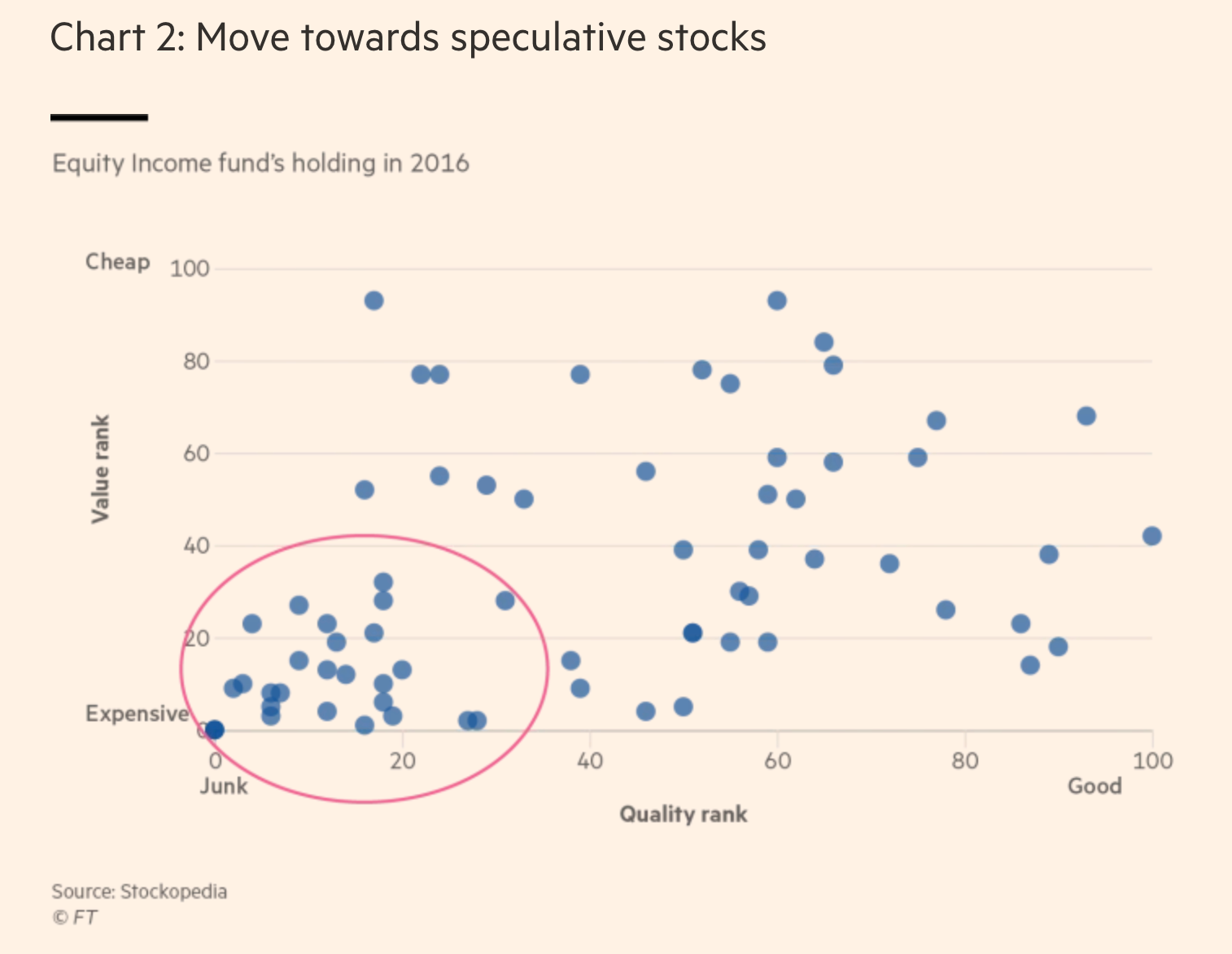

A useful and informative article. The suggestions for extending the remit of Stockopedia to cover fund analysis need to be carefully considered as they could eat into the resources currently used to provide your excellent analysis of individual stocks, particularly as there are thousands of OEICs. You do currently provide a service for investment trusts which are both individual stocks and funds at the same time. Unfortunately this service is of limited use to investors like myself who specialise in investment trusts, because many factors which are key indicators of investment success for investment trusts are missing from your current accountancy focussed analysis. An inexperienced investor looking at an investment trust on your site could easily be misled into making wrong decisions. If you are interested in improving the information you provide on investment trusts, I would be willing to assist you.
John Sydney.

Hi John,
I agree completely with your comments on Stockopedia's service for investment trusts (ITs).
I like to use Stockopedia's Folios option to compare the performance of various ITs I'm interested in, because of its convenience and many useful features. There is some useful information provided by Stockopedia that is not available on other web sites, such as the bid-offer spreads of ITs.
However, one crucial item of data for investment trusts that is not currently provided by Stockopedia is the discount of the IT's share price to its Net Asset Value. It is possible to find the discount on some free web sites, such as that of the Association of Investment Companies: www.theaic.co.uk, but it is inconvenient to flit from one web site to another. It would be great if Stockopedia provided discounts for ITs, but I have been asking for this regularly for several years and it has never been provided - I don't understand why.

PKA - can't you just look at the share price and the book value per share - which are both given on the summary page?

Hi shipoffrogs, the share price is updated each day, but the book value per share on the summary page is a TTM (Trailing Twelve Month) value, which could be several months old. The Net Asset Value of an investment trust can change daily, because it is based on the fluctuating share prices of all the stocks that are in the investment trust's portfolio. Therefore comparing the share price and the book value per share is not a reliable way to calculate the current discount to NAV of an investment trust.

Here's an article which suggests that Woodford didn't change his style over the years:
https://portfolio-adviser.com/peter-sleep-how-a-passive-manager-spotted-woodford-red-flags-in-2011/

Wow! Great post.
I had thought, wrongly it seems, that when he started Patient Capital the investment in the small, speculative and sometimes unquoted companies were companies that he wasn’t invested in at Invesco and that Patient Capital was a very different beast. It seems that he just invested again in many of same companies artificially inflating their value and making them even less liquid.

I think your aspirations about being able to expose the individual holdings of funds for investors potentially very useful but probably very difficult.
When purchasing a Fund myself, I check its major holdings when doing so, but when I have done a review a few years later being surprised and disappointed to find significant differences in major holdings. It makes the decision to "stick" with a Fund complicated when most people pick a fund and WANT to stick with it, on the basis of the first examination of stocks held.
This gives weight to the concept of buying individual stocks as better, in respect of knowing what you actually own and being able to track and understand performance.
Peter Sharp

The Financial Times notes that Mr Woodford and Craig Newman have collected £112 million in dividend payments since 2014, including £13.8 million in the company's full final year. All this whilst 300,000 investors are still trapped in their underperforming fund. It is profoundly disturbing that the FSA can do nothing about this. There is a powerful argument for transferring all funds from active funds to passive funds.
It would be a good idea I think for all active fund managers to have their entire personal fortunes locked in to the performance of their funds against their stated benchmark. It would discourage both the recklessness and the disturbing practice of inflating the NAV by dubious means that we have seen in Woodford's fund(s).

The FSA should insist that Woodford repays from his dividends the £32 million of his clients' money that he 'invested' in May 2015 in Industrial Heat, a company working on cold fusion:
https://ftalphaville.ft.com/2016/11/25/2180322/so-neil-woodford-invested-in-a-cold-fusion-company/
Woodford showed incredible stupidity, negligence and irresponsibility in doing that. There was and is no chance of there ever being a return on that 'investment' which is in reality worth zero because cold fusion is "impossible according to our current understanding of physics", unless there is an even 'greater fool' than Woodford willing to buy that stake in Industrial Heat from his former fund and investment trust.
*Past performance is no indicator of future performance. Performance returns are based on hypothetical scenarios and do not represent an actual investment.
This site cannot substitute for professional investment advice or independent factual verification. To use Stockopedia, you must accept our Terms of Use, Privacy and Disclaimer & FSG. All services are provided by Stockopedia Ltd, United Kingdom (company number 06367267). For Australian users: Stockopedia Ltd, ABN 39 757 874 670 is a Corporate Authorised Representative of Daylight Financial Group Pty Ltd ABN 77 633 984 773, AFSL 521404.


Ed,
Excellent analysis, which shows the advantage of looking closely at Stocko Ranking and Speculative scores. See you at Mello. Ian